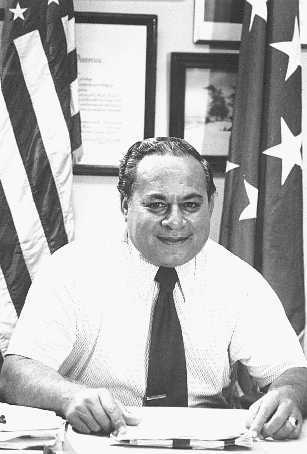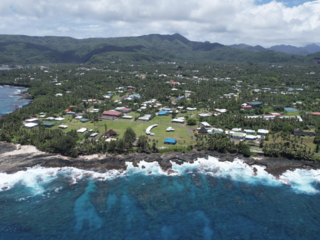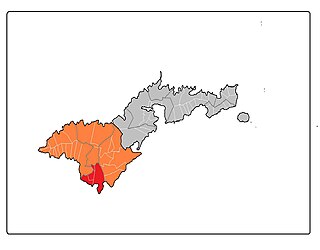
Peter Tali Coleman was an American Samoan politician and lawyer. Coleman was the first and only person of Samoan descent to be appointed governor of American Samoa between 1956 and 1961 and later became the territory's first and third popularly elected governor from 1978 to 1985 and 1989 to 1993, serving a total of three elected terms. In between, he had served in different administrative positions for Pacific islands.

American Samoa Community College (ASCC) is a public land-grant community college in the village of Mapusaga, American Samoa. Only legal residents of American Samoa who have graduated from high school or obtained a General Equivalency Diploma are admitted to ASCC.

The American Samoa Fono is the territorial legislature of American Samoa. Like most states and territorial legislatures of the United States, it is a bicameral legislature with a House of Representatives and a Senate. The legislature is located in Fagatogo along Pago Pago harbor.

The American Samoa House of Representatives is the lower house of the American Samoa Fono. The House consists of 21 members serving two-year terms, with 20 popularly elected representatives, and one delegate from Swains Island elected in a public meeting.

Fagatogo is the downtown area of Pago Pago. Located in the low grounds at the foot of Matafao Peak, it was the location of the first American settlement on Tutuila Island. It includes the sub-village of Malaloa. Today, Fagatogo is the government, commercial, financial, and shipping center of Tutuila. It is also the administrative capital of American Samoa. It is the location of the American Samoa Fono (legislature), and is listed in the Constitution of American Samoa as the territory's official seat of government. Its population is 1,737.
Utulei or ʻUtulei is a village in Maoputasi County, in the Eastern District of Tutuila, the main island of American Samoa. Utulei is traditionally considered to be a section of Fagatogo village, the legislative capital of American Samoa, and is located on the southwest edge of Pago Pago Harbor. Utulei is the site of many local landmarks: The A. P. Lutali Executive Office Building, which is next to the Feleti Barstow Library; paved roads that wind up to a former cablecar terminal on Solo Hill; the governor's mansion, which sits on Mauga o Alii, overlooking the entrance to Goat's Island, and the lieutenant governor's residence directly downhill from it; the Lee Auditorium, built in 1962; American Samoa's television studios, known as the Michael J. Kirwan Educational Television Center; and the Rainmaker Hotel. Utulei Terminal offers views of Rainmaker Mountain.

The Seal of American Samoa is based in traditional local design.

Leone is the second-largest city on Tutuila Island's west coast. The village is on the south-west coast of Tutuila Island, American Samoa. Leone was the ancient capital of Tutuila Island. Leone was also where the Samoan Islands’ first missionary, John Williams, visited on October 18, 1832. A monument in honor of Williams has been erected in front of Zion Church. Its large church was the first to be built in American Samoa. It has three towers, a carved ceiling and stained glass. Until steamships were invented, Leone was the preferred anchorage of sailing ships which did not risk entering Pago Pago Harbor. Much early contact between Samoans and Europeans took place in Leone.

The American Samoa Power Authority (ASPA) is a government-run public utility company providing electricity, water, wasterwater, and waste disposal services within American Samoa.
Anua is a village on Tutuila Island, American Samoa. It is located close to the capital Pago Pago, on the coast of Pago Pago Harbor. The term Pago Pago is often used for several settlements on Pago Pago Bay, including Anua, Lepua, Utulei, and others.
Samoana High School (SHS) is a prominent high school in Utulei, a community in Maoputasi County, Eastern District, American Samoa. It is a part of the American Samoa Department of Education.

Leone High School is a senior high school in Vailoatai and Leone, in the Western District, American Samoa. It is operated by the American Samoa Department of Education. It is the second-largest high school on Tutuila Island.

The Jean P. Haydon Museum is a museum in Pago Pago dedicated to the culture and history of the United States territory of American Samoa. It contains a collection of canoes, coconut-shell combs, pigs’ tusk armlets and native pharmacopoeia. It also houses exhibits on natural history, tapa making, traditional tattooing, as well as a collection of war clubs, kava bowls, and historic photographs. Constructed in 1913 as U.S. Naval Station Tutuila Commissary, the building was home to Tutuila Island's Post Office from 1950 to 1971. The museum has displays of various aspects of the Samoan Islands’ culture and history. It is the official repository for collections of artifacts for American Samoa. Funded by the American Samoa Council on Arts, Culture and the Humanities, it is the venue used for numerous of the cultural resource activities in American Samoa.

Vailoatai is a village in southwestern Tutuila, the main island of American Samoa. It is located on the eastern end of Leone Bay. The village is known for its beautiful malae, nested along the island's rugged southern coast and lined by the fale tali mālō of its village chiefs.
Pava'ia'i is a village in the Western District of Tutuila Island in American Samoa. It borders Mapasagafou and Faleniu to the north, 'Ili'ili to the east, Futiga to the south, and Malaeloa to the west. It is located in Tuālāuta County.
Feleti Barstow Public Library is the main library in American Samoa, and is located in the village of Utulei in Maoputasi County. It is the central public library for the territory and is situated immediately across from the Office of Tourism, next to the Executive Office Building, and just behind Samoana High School. Besides a permanent display depicting American Samoa’s involvement in the Apollo Space Program, the library has also worked with the American Samoa Historic Preservation Office (ASHPO) since 2000 at creating a historic Polynesian Photo Archive. The goal of the project has been to electronically catalog and archive around 6,000 still and moving images of Polynesia which were collected by the American Samoa Government. The library has an extensive Pacific Collection which houses articles, books, and reports relevant to Pacific- and Samoan history. A large collection of photographs are stored in its Polynesian Photo Archive, which is a subset of their Pacific Collection.

Lyndon B. Johnson Tropical Medical Center is the only hospital in American Samoa, and is located in Faga'alu, Maoputasi County. It has been ranked among the best hospitals in the Pacific Ocean. It is home to an emergency room and there are doctors on duty at all hours. It is a 150-bed facility. It includes TB, leprosy and obstetric units. The hospital was built in 1968 and is operating under a $50 million budget as of 2017. The executive director is Taufete'e John Faumuina.

Tuālā-tai County is one of the five counties that make up the Western District of American Samoa.
Aumoeualogo Te’o J. Fuavai was a former American Samoa politician who represented the Republican Party of American Samoa and served as a member of the American Samoa House of Representatives, as a territorial Senator, and Speaker of the House of Representatives. He has also been the Commissioner of Public Safety, Director of Public Works, President of the American Samoa Rugby Union (1976-2019), Chairman of the Catholic Diocesan Council, and Chairman of the Republican Party of American Samoa.
Itū'au, together with Aitūlagi, make up the village of Malaeloa.













